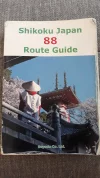BobM
Veteran Member
- Time of past OR future Camino
- V Frances; V Podensis; V Francigena; V Portugues; V Francigena del Sud; Jakobsweg. Jaffa - Jerusalem
The 88 Temple Pilgrimage (Henro Michi) around Shikoku Island, Japan may not be as well-known as pilgrimage routes in Europe, but it is a uniquely different experience that is worth considering as an alternative long-distance pilgrimage.
I just finished reading Robert Sibley’s book, The Way of the 88 Temples - Journeys on the Shikoku Pilgrimage , which is a wonderful read. Just about every page has something that resonates with me. Before reading this book, I thought I had long distance walks pretty much figured out, but Sibley has given me many new insights. Now I am not so sure that I have much figured out at all.
First up would be mindfulness, ‘being in the moment’, a very Buddhist concept which is also helpful to non-Buddhists in managing stress and anxiety, among other problems. Sometimes it is better not to use labels like ‘Buddhism’ because they carry psychological baggage that can interfere with the usefulness of the techniques themselves.
Like Sibley, I often experienced intense moments of ordinariness on my walks, maybe when my attention was arrested by a flower by the trail, or dew-drops on a spider web catching the early morning sun. Being in the moment and focussing intently on an object or a phrase – or just counting steps! - sometimes helped me to endure difficult climbs by taking my mind to another place and letting the body take care of itself.
Then there is the transience of all things, and the unimportance of material possessions – an eccentricity so at variance with modern materialistic life that it probably borders on the peculiar for most people.
Sibley talks about the psychological challenges of long walks, another bond of familiarity we share. When I mention it to people who have never walked much, they sometimes look oddly at me, as if I have a problem of some sort and might attack them out of the blue, so I let the subject drop. Only fellow-pilgrims can really understand the often-changing mental states of long-distance walkers.
The evolving story of Shuji and Jun as recounted by Sibley as possibly the major theme of his book is very moving, but I was a little ambivalent about Sibley’s use of such deeply personal material. Possibly he had their permission - or disguised their names to protect them, which in itself would be an injustice to those two people.
Bearing witness can be painful and involve deep issues of conscience, but sometimes it is a necessary thing to do, a way of paying tribute to the people involved. Such decisions are never easy – nor should they be. Photographers and camera crews in war zones or covering natural tragedies face a similar moral dilemma every time they encounter the more brutal realities of their jobs, which require them to bear witness, but not to get personally and directly involved.
On long walks, we may store up regrets for things not done, for taking mental and physical shortcuts and for moments of discourtesy born of tiredness and malaise. I have my share of those tucked away in uneasy corners of my being which sometimes rise unbidden to chafe my conscience. But regrets are not helpful, apart from their temporary value as spurs to leading a better life. Sibley quotes Itsue Takamure, a Japanese pilgrim who wrote a series of newspaper articles about her trek on the 88 Temple Pilgrimage. She finished her articles with the phrase “Let everything be as it is”; seemingly simple, but possibly one of the most difficult of all aphorisms to live up to.
Given the importance of correct behaviour and the performance of the appropriate rituals, some knowledge of Japanese culture and language is probably more desirable on pilgrimages in Japan than elsewhere. Not only to avoid unknowingly offending the Japanese, but also to bond more closely with the people we meet along the way. Sibley recounts numerous examples to bear in mind; from the correct behaviour in public bathing, to the proper rituals at temples, for example reciting the Heart Sutra.
Settai (roughly ‘alms’) is a potential minefield for foreigners and I am grateful for Sibley’s explanations of this important custom. By offering settai, many Japanese along the Henro Michi believe that something of the merit a pilgrim acquires rubs off on them. On my own travels, offers of help were sometimes devices to get me to buy something; so I often look for ulterior motives when strangers approach me with offers of help. What a rude faux pas that would be in a settai situation.
‘Ceremonial’ drinking is culturally important in many Japanese contexts, but it is another minefield for non-drinkers like me. Sibley’s book reminds me that if I embark on my own pilgrimage in Japan I need to figure out a polite way to decline drinking alcohol without offending Japanese companions or making them feel uncomfortable. The old standby of “I am taking medication and must not drink alcohol right now” might not be good enough faced with a perceptive audience!
As a novice walking the Camino to Santiago, Spain over a decade ago, I was often amazed by miraculous coincidences and by trivial events that seemed to have a special, personal significance. After thinking about these experiences, I came to the rather cynical conclusion that they were all simply matters of probability and too much introspection. Sibley’s book points out that what I might call ‘miraculous thinking’ among secular pilgrims is a well-known psychological effect that eventually becomes quite a common experience to many people on all long pilgrimages. Something else to re-evaluate.
Japanese people often wished Sibley ‘gambatte kudasai’ (roughly ‘please do your best’, or ‘good luck’). I first heard the phrase in an NHK documentary about the arduous experience of a Japanese Canadian following the stations of Fuji-san – part of her quest to reconnect with her Japanese roots - so I looked it up: https://www.italki.com/question/166631 . It has connotations of caring and community-feeling that formulaic Western phrases like ‘have a nice day’ often lack.
Sibley gives a useful account of the ‘fusion’ of Buddhism and Shintoism in Japanese spiritual practices. It is an excellent reminder that all belief systems have something to offer; none is intrinsically better than another. The Japanese personification of Fuji-san is one delightful example that enriches their daily lives as they observe with affection the seasonal changes that affect Mount Fuji.
I admire Sibley’s writing technique, the structure of his book and his choice of material. I try to take notes for my own books as I walk, especially of ephemeral (but important) things which catch my attention, and I make time to write them up at the end of the day among all my other chores, but it is not always easy. After a couple of weeks on the road, the days can become something of a blur and the intensity of fleeting impressions can fade. Sibley has succeeded brilliantly with his insightful and often moving observations of small things, recorded over a period of two months on the 88 Temple Pilgrimage.
While the book is specifically about Sibley’s experiences on the 88 Temple Pilgrimage, his insights and helpful references to more general topics apply to any pilgrimage. His book is worth reading by all pilgrims – even veterans like me who think they have it all figured out.
Sibley also uploaded a daily journal to the web when the opportunity allowed. His unedited musings can be found at: http://www.shikokuhenrotrail.com/shikoku/thoughts1999/shikokuthoughts.html
I just finished reading Robert Sibley’s book, The Way of the 88 Temples - Journeys on the Shikoku Pilgrimage , which is a wonderful read. Just about every page has something that resonates with me. Before reading this book, I thought I had long distance walks pretty much figured out, but Sibley has given me many new insights. Now I am not so sure that I have much figured out at all.
First up would be mindfulness, ‘being in the moment’, a very Buddhist concept which is also helpful to non-Buddhists in managing stress and anxiety, among other problems. Sometimes it is better not to use labels like ‘Buddhism’ because they carry psychological baggage that can interfere with the usefulness of the techniques themselves.
Like Sibley, I often experienced intense moments of ordinariness on my walks, maybe when my attention was arrested by a flower by the trail, or dew-drops on a spider web catching the early morning sun. Being in the moment and focussing intently on an object or a phrase – or just counting steps! - sometimes helped me to endure difficult climbs by taking my mind to another place and letting the body take care of itself.
Then there is the transience of all things, and the unimportance of material possessions – an eccentricity so at variance with modern materialistic life that it probably borders on the peculiar for most people.
Sibley talks about the psychological challenges of long walks, another bond of familiarity we share. When I mention it to people who have never walked much, they sometimes look oddly at me, as if I have a problem of some sort and might attack them out of the blue, so I let the subject drop. Only fellow-pilgrims can really understand the often-changing mental states of long-distance walkers.
The evolving story of Shuji and Jun as recounted by Sibley as possibly the major theme of his book is very moving, but I was a little ambivalent about Sibley’s use of such deeply personal material. Possibly he had their permission - or disguised their names to protect them, which in itself would be an injustice to those two people.
Bearing witness can be painful and involve deep issues of conscience, but sometimes it is a necessary thing to do, a way of paying tribute to the people involved. Such decisions are never easy – nor should they be. Photographers and camera crews in war zones or covering natural tragedies face a similar moral dilemma every time they encounter the more brutal realities of their jobs, which require them to bear witness, but not to get personally and directly involved.
On long walks, we may store up regrets for things not done, for taking mental and physical shortcuts and for moments of discourtesy born of tiredness and malaise. I have my share of those tucked away in uneasy corners of my being which sometimes rise unbidden to chafe my conscience. But regrets are not helpful, apart from their temporary value as spurs to leading a better life. Sibley quotes Itsue Takamure, a Japanese pilgrim who wrote a series of newspaper articles about her trek on the 88 Temple Pilgrimage. She finished her articles with the phrase “Let everything be as it is”; seemingly simple, but possibly one of the most difficult of all aphorisms to live up to.
Given the importance of correct behaviour and the performance of the appropriate rituals, some knowledge of Japanese culture and language is probably more desirable on pilgrimages in Japan than elsewhere. Not only to avoid unknowingly offending the Japanese, but also to bond more closely with the people we meet along the way. Sibley recounts numerous examples to bear in mind; from the correct behaviour in public bathing, to the proper rituals at temples, for example reciting the Heart Sutra.
Settai (roughly ‘alms’) is a potential minefield for foreigners and I am grateful for Sibley’s explanations of this important custom. By offering settai, many Japanese along the Henro Michi believe that something of the merit a pilgrim acquires rubs off on them. On my own travels, offers of help were sometimes devices to get me to buy something; so I often look for ulterior motives when strangers approach me with offers of help. What a rude faux pas that would be in a settai situation.
‘Ceremonial’ drinking is culturally important in many Japanese contexts, but it is another minefield for non-drinkers like me. Sibley’s book reminds me that if I embark on my own pilgrimage in Japan I need to figure out a polite way to decline drinking alcohol without offending Japanese companions or making them feel uncomfortable. The old standby of “I am taking medication and must not drink alcohol right now” might not be good enough faced with a perceptive audience!
As a novice walking the Camino to Santiago, Spain over a decade ago, I was often amazed by miraculous coincidences and by trivial events that seemed to have a special, personal significance. After thinking about these experiences, I came to the rather cynical conclusion that they were all simply matters of probability and too much introspection. Sibley’s book points out that what I might call ‘miraculous thinking’ among secular pilgrims is a well-known psychological effect that eventually becomes quite a common experience to many people on all long pilgrimages. Something else to re-evaluate.
Japanese people often wished Sibley ‘gambatte kudasai’ (roughly ‘please do your best’, or ‘good luck’). I first heard the phrase in an NHK documentary about the arduous experience of a Japanese Canadian following the stations of Fuji-san – part of her quest to reconnect with her Japanese roots - so I looked it up: https://www.italki.com/question/166631 . It has connotations of caring and community-feeling that formulaic Western phrases like ‘have a nice day’ often lack.
Sibley gives a useful account of the ‘fusion’ of Buddhism and Shintoism in Japanese spiritual practices. It is an excellent reminder that all belief systems have something to offer; none is intrinsically better than another. The Japanese personification of Fuji-san is one delightful example that enriches their daily lives as they observe with affection the seasonal changes that affect Mount Fuji.
I admire Sibley’s writing technique, the structure of his book and his choice of material. I try to take notes for my own books as I walk, especially of ephemeral (but important) things which catch my attention, and I make time to write them up at the end of the day among all my other chores, but it is not always easy. After a couple of weeks on the road, the days can become something of a blur and the intensity of fleeting impressions can fade. Sibley has succeeded brilliantly with his insightful and often moving observations of small things, recorded over a period of two months on the 88 Temple Pilgrimage.
While the book is specifically about Sibley’s experiences on the 88 Temple Pilgrimage, his insights and helpful references to more general topics apply to any pilgrimage. His book is worth reading by all pilgrims – even veterans like me who think they have it all figured out.
Sibley also uploaded a daily journal to the web when the opportunity allowed. His unedited musings can be found at: http://www.shikokuhenrotrail.com/shikoku/thoughts1999/shikokuthoughts.html
Last edited:

























